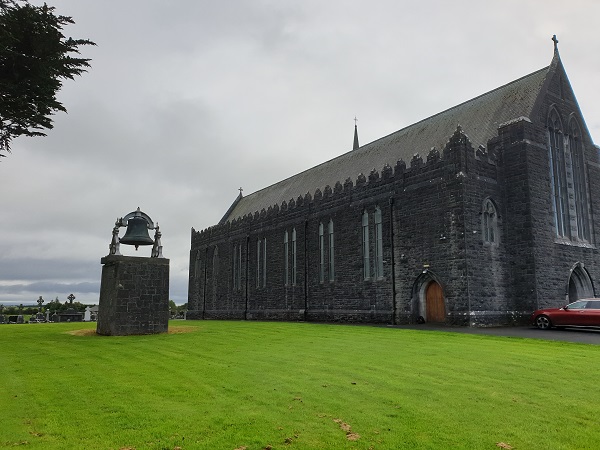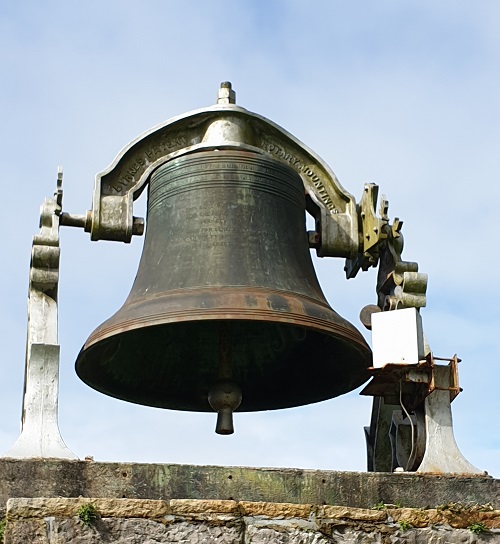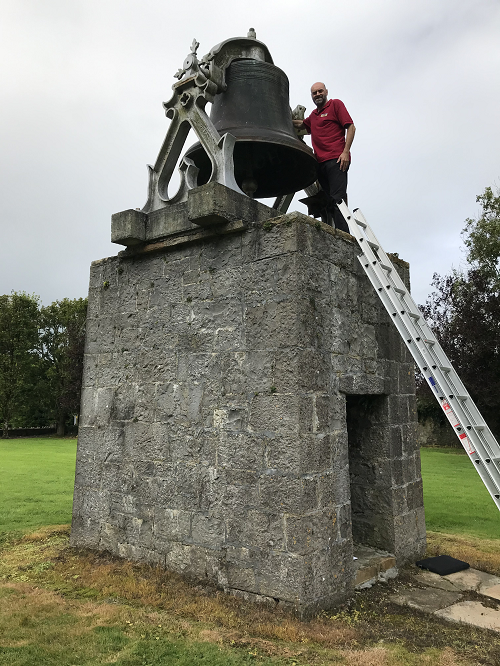This article was originally published in The Ringing World of 2 October 2020, issue 5710, page 968.
In Chris Pickford’s list of Great Bells (see below for link), the biggest bell cast by William Dobson is listed as 43cwt, originally at Dublin Post Office, and now in County Mayo, Ireland. As part of an investigation into the tuning of Dobson bells, I set out to find and record this bell.
Chris’ source for the weight of the bell is this piece in the Norfolk Chronicle, Sat. 15 Nov. 1817:
“We are informed there have been recently cast at the foundery at Downham, in this county, five clock bells, (the largest weighing 43 cwt, and a very fine bell) for the New General Post-office, Dublin, and a large bell is now preparing at the same place, for a church erecting in the Wabash Indiana State, North America, by a religious society of Germans, who have lately settled themselves in that quarter of the globe.”
William Dobson was a bellfounder working in Downham Market, Norfolk in the early 19th century. He inherited the bellfoundry in 1806 from his grandfather Thomas Osborn who originally worked with Joseph Eayre in St Neots and moved to Downham Market in the middle of the 18th century. Among peals by William Dobson which still survive, some since retuned, are Wisbech (his only surviving ten), eights at Ashbourne, Diss, Elland, Liversedge and Poole, several sixes and fives, and a considerable number of individual bells. He cast a twelve for St Nicolas, Liverpool in 1812, since replaced. Dobson sold his foundry to Mears in 1833 and left the trade, going to work in a lawyer’s office in London.
William Dobson’s bells are tonally of high quality. His best bells are closer to true-harmonic than those of any UK bellfounder until Taylors re-discovered true-harmonic tuning, following Simpson’s papers, in the mid 1890s. In a true-harmonic bell, three of the five lowest partial frequencies (the hum, prime and nominal) are in perfect octaves. Dobson’s bells are consistently better than those of his grandfather Thomas Osborn. He did not have a tuning machine so the tonal quality of his bells is solely due to design and profiles. A design chart of his survives in the Whitechapel Bellfoundry archive, but the chief record we have of his work is the bells that survive. To see how Dobson bells compare with other founders of the period see the page describing my ongoing investigation.
I wanted to find the bell in County Mayo to find out if it was in fact the William Dobson bell, and to see how its sound compared with his smaller bells. After an extended search on the internet I found a photograph and description of the bell on the website of St Cronan’s church, Balla, County Mayo. Taking advantage of a holiday in Ireland only eight hours’ drive from Balla, I contacted the parish priest for permission to inspect the bell. I visited on 8 September 2020.

The bell is mounted on a stone plinth in the churchyard, on a cast-iron yoke and frame by Byrne of Dublin. The two-line inscription on the bell confirms its origin, the first line reads:
THE RIGHT HONORABLE CHAS EARL O’NEILL K.P. AND LAURENCE EARL OF ROSSE POSTMASTERS GENERAL OF IRELAND; EDWARD SMITH LEES ESQR; SECRETARY
and the second line reads:
THIS BELL WAS CAST BY WILLIAM DOBSON, OF DOWNHAM NORFOLK, ENGLAND IN THE YEAR ONE THOUSAND EIGHT HUNDRED AND SEVENTEEN
An inscription incised on its waist gives the subsequent history:
THIS BELL WAS ACQUIRED AND REMOUNTED
FOR THE PARISH OF BALLA AD 1917
VERY REV THOMAS J REIDY P.P.
CAST FOR GENERAL POST OFFICE DUBLIN 1817
REMOVED TO THE ROYAL UNIVERSITY OF IRELAND DUBLIN 1884
ERECTED IN BALLA 1918

The six canons on the bell have been removed, and the bell bolted through the stumps of the canons to a cast-iron pad. The yoke has fittings for wheel spokes but the bearings are now seized and the bell is sounded with an electric striker. The bell has four clapper scars inside the rim so it has been quarter-turned, though not since arriving in Balla, judging by the position of the incised inscription.

The bell is a good casting and has a lovely tone. The partial frequencies are as follows:
| Hum | Prime | Tierce | Quint | Nominal | Superquint | Octave Nominal | |
|---|---|---|---|---|---|---|---|
| Freq (Hz) | 126.0 | 257.9 | 300.1 | 379.5 | 499.3 | 746.0 | 1028.2 |
| Cents to nominal | -2383.8 | -1143.7 | -881.4 | -475.0 | – | 695.1 | 1250.6 |
| True-harmonic | -2400.0 | -1200.0 |
The hum is only 16 cents (hundredths of a semitone) sharp of a perfect double-octave. The prime is 56 cents sharp of the octave. Sharp primes are quite unusual, the sharpness is due in this case to the thickness of the bell in the shoulder. For comparison, a Mears bell of this period would on average have a hum which is 130 cents sharp and a prime which is 128 cents flat, both very considerably worse.
The bell’s diameter is 1.58m or 5ft 2.2in. My estimate of its weight based on diameter and partials is 2096kg or 41cwt 1qtr. The difference from the original estimate is no doubt due to the removal of the canons. The weight quoted in the church guidebook of 2 1/2 tons at the time it was moved to Balla probably includes the yoke and frame.
The parish of St Cronan value the bell, it is described in the church guidebook as ‘an interesting and sweet-toned bell, which is of very historical significance’.
My thanks are due to Father Denis Carney for permission to inspect the bell, a warm welcome, and the loan of a ladder; to George Elphick and Chris Dalton for Dobson’s history; and to Chris Pickford for the Norfolk Chronicle reference and for the Great Bells list entry that inspired the search.
After publication of this article in The Ringing World, John Eisel contacted me with further information about the bell. It was originally located by Fred Dukes, who provides details, but only an approximate location, in his book Campanology in Ireland published in 1994. Fred located the bell in 1982 and visited it to take details in August 1984. Tim Jackson also contacted me to say that Martin Turner had visited the bell in 2013 to confirm its existence as part of the work Tim was doing to update the Great Bells list in Dove.
References
Great Bells of Britain, available from The Keltek Trust downloads
Sussex Bells and Belfries, George Elphick, Phillimore 1970, page 145
Dorset Bells, Chris Dalton, Upper Court Press 2005, part III pages 944/5
Norfolk Chronicle, Sat 15 Nov 1817.